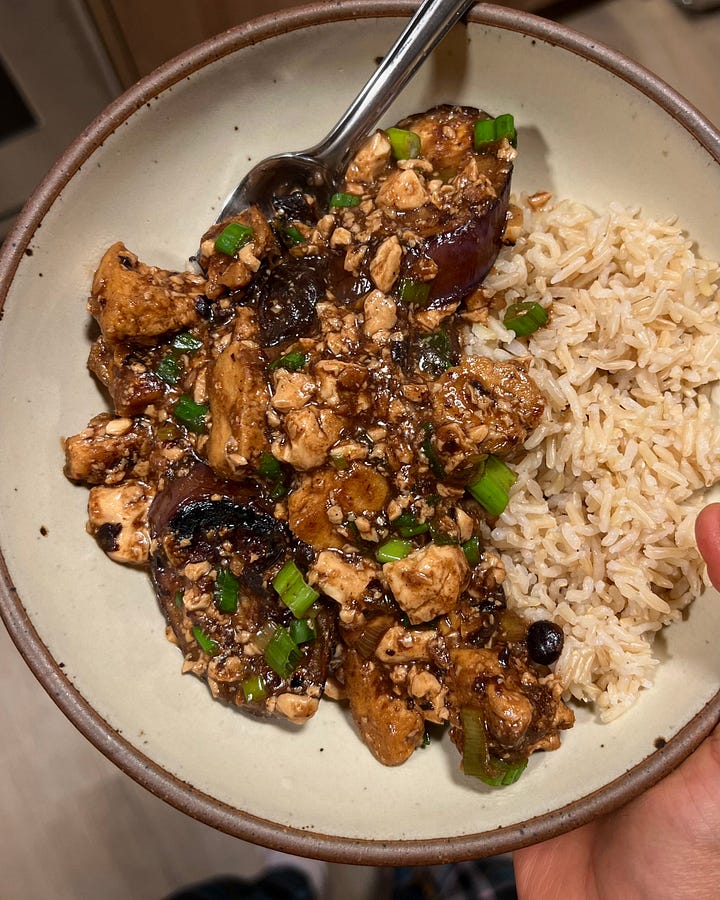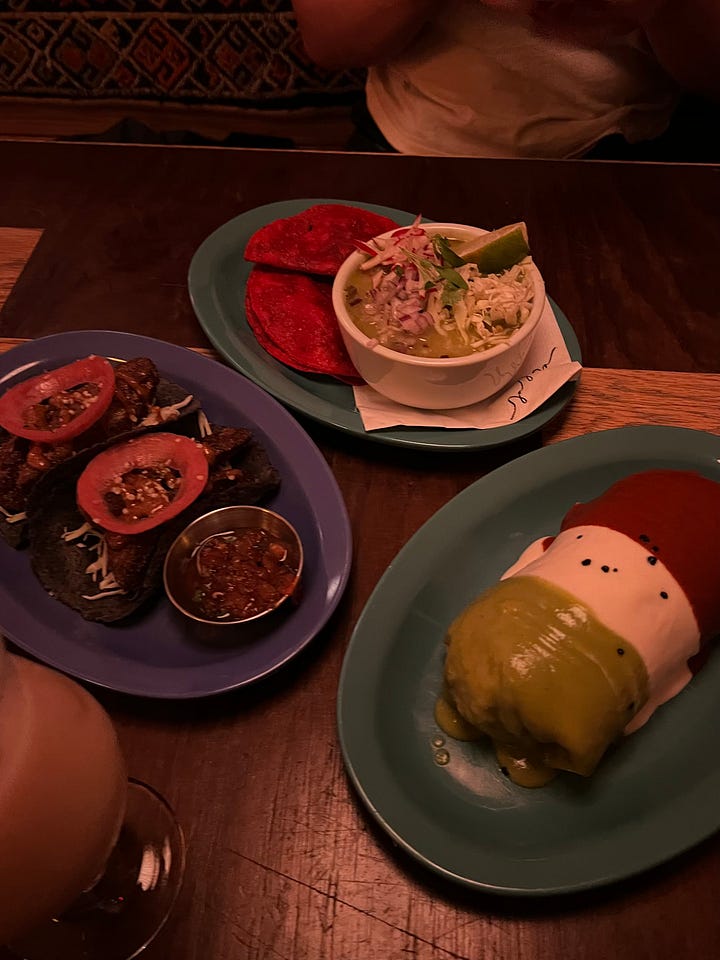At my current job, I come up with recipes for culinary educators to teach at cooking classes. Sometimes I’m the one teaching the classes, and last week, I taught kids! The kids brought an energy the adults could never match, bombarding me with questions about whether Gordon Ramsay is considered the best chef (lol) and why these olives have seeds in them. As I imparted my onion-cutting skills, I learned about skibidi toilets and Ice Spice. The 10-year-old who educated me about the latter’s “bussin” music cut herself, but knife injuries aside, the rest of it went smoothly. We baked pizzas with premade flatbread crusts, Rao’s marinara sauce, melty cheese, and veggies. Despite the kids’ excitement about cutting vegetables, they refused to put them on their pizzas, fulfilling the stereotype about children’s diets. Regardless, they had a great time and I found it cute that they saved half their pizza for their parents.
When deciding on recipes for adults and kids, I try to think of affordability, availability of ingredients, cultural diversity, skill level, required kitchen appliances, and nutritional value, all of which contribute to how accessible a recipe feels to someone. Anything that can’t be found at the local supermarket is off limits. No high-speed blenders, pressure cookers, or air fryers.
It’s important to note that I work in supportive housing, where “access” is a complicated term loaded with multiple meanings. From Brooklyn to the Bronx, our organization serves individuals who were formerly unhoused, in foster care, or experienced other circumstances that brought them to supportive housing. Some of our sites house families, while others house those who have faced trauma or substance abuse. Many tenants experience diet-related health conditions, which I try to be mindful of while sharing recipes that are nutrient-dense yet feel indulgent, leaving no room to demonize ingredients. It’s not difficult to conclude that most cookbooks and blogs that focus on “healthy food” may not seem appealing or accessible to populations that community health organizations like ours serve.
As I write recipes every week, I adapt the recipes I find online with our tenants in mind, which is why I’ve been thinking about what makes a recipe accessible. When recipe developers call a recipe “easy” or “affordable,” who is it easy and affordable for? Their target audience seems to be middle class or higher, with ample grocery stores and appliances, while recipes for those who live in a food apartheid are not as mainstream or easy to find. The evidence: Reddit is on the front page of Google search results for “recipes if you live in a food desert.”
I occasionally feel out of place while incorporating the food justice movement and nutrition equity into our classes, given that I’ve never experienced food insecurity and grew up in a small family that frequents three grocery stores to put a diversity of foods on the table. To bridge the gap, I try my best to understand what people want to eat, which foods feel comforting, and the skills they can execute in their kitchens. Some units have complete kitchens while others are limited to a microwave, forcing a reliance on daily catered meals or college dorm cooking. While I thought Trader Joe’s was widely considered an affordable grocery store, one tenant expressed that it’s so expensive it doesn’t feel worth it to make the trek for their peanut butter pretzels. There aren’t even any locations in Harlem and the Bronx, because Trader Joe’s is intentional about not establishing itself in low-income neighborhoods.
After getting to know people and taking a look at the recipes used by my organization in the past, I caught my recipe pet peeves like an editor with a red pen: the word “easy” in the recipe title, the use of curry powder, ingredients listed out of the order in which they’re used, ingredients listed in unclear quantities, and the westernization of traditionally non-Western recipes.
Can plant-based recipes be accessible in spaces with limited resources?
Most of our recipes are not vegan, given what we know about our tenants’ preferences. Of course, writing recipes that encourage meat consumption feels deeply problematic to me due to meat’s association with diet-related diseases and industrial agriculture. It feels problematic because I resonate with veganism not only as an individual way of eating, but as a movement that plays a part in spurring collective action by reducing demand for meat and encouraging diverse plant-based options.
But the role that veganism can play in nutrition and culinary education is a topic I’d like to consider more deeply another time, and it requires confronting what veganism represents to different people. Some may view it as a restrictive diet, which must feel disempowering to anyone with a history of food insecurity. I can provide a vegan or vegetarian alternative in the recipe’s notes, but sometimes this is going to feel even less accessible to tenants who have voiced that they need meat to feel emotionally and physically satisfied. I wholeheartedly believe the centricity of animals on our plates must be dismantled for several reasons, but it feels wrong to address this belief in these spaces, where I’m constantly reminded of the ubiquity of food injustices and diet-related disparities.
Still, I try to showcase fun plant-based options whenever I can. Most of all, I want to counteract Eurocentrism in nutrition through the recipes, as almost all of our tenants are BIPOC folks. The quality of the ingredients shall not do the cooking, unlike recipes that instruct you to find good olive oil and good produce and fresh herbs – a privilege that many can’t afford – we do the cooking. So far, the recipes have been hits, driving up participation (which I’ve learned is rare in the nonprofit world)! I end up with photos of po’boys, banh mis, Indian vegetable puffs, and chicken creole in my inbox, always with a bite or five already taken.
Considering access and the simplification of cuisines in social media food content
Thinking about what makes a recipe accessible to people with limited resources makes me wonder what it means to create accessible recipes on social media, which reach a diverse population of home cooks. This question is complicated by the unfortunate fact that household food insecurity is on the rise again in the US, as pandemic benefits are cut. By talking to tenants at our supportive housing sites, I’ve become more aware of the limitations that they face when purchasing groceries and feeding their families, yet they are also exposed to a food media scene that tends to cater to an audience with greater resources.
Since I’ve been trying to develop recipes from diverse cultures for our classes, this process brings up the conflict of oversimplifying cuisines in pursuit of an easy recipe. I’ll admit that I tend to omit some key ingredients because I can’t expect people to have them lying around. However, several recipe developers hold the expectation that people should acquaint themselves with a culture-specific grocery store to make their recipes. This expectation isn’t unjustified – during the racial reckoning in 2020, food media amplified critiques of the oversimplification of non-Western recipes. Creators of color voiced that they should not feel pressured to provide substitutions for ingredients essential to their culture’s food. For example, there really is no substitute for kasoori methi (dried fenugreek leaves) or hing (asafetida) in Indian cuisine. Still, to welcome people who don’t live near a diversity of affordable grocery stores, it is inadequate to say “go to your local Indian store” and leave it at that. Sometimes the word “optional” next to an ingredient as transformative as kasoori methi feels wrong, but if it welcomes someone, it must be right.
Circling back the question that formed the title of this newsletter: do accessible recipes exist? I think it depends on how we define access and who the audience is. I don’t think it’s possible for recipes to be perfectly accessible because of the food system we live with, varying skill levels, geographic access dependent on seasons, and financial resources.
I don’t find it unreasonable for recipe developers to assume access to basic ingredients. After all, in a just food system, people would have access to basic ingredients. Recipe writing alone isn’t powerful enough to increase access to what should be accessible, but it can be part of it, especially if the language shifts to acknowledge inequitable access.
Then there is the background of people who publish recipes. I’d imagine that most people who develop recipes as a hobby or for a living have the privilege of time (and therefore, the privilege of money) to spend on culinary endeavors that go beyond the responsibility of feeding a family, so it’s not surprising that their recipes mirror their own circumstances. Recipe developers operate within the bubble of what they have access to, so bursting this bubble could mean expressing an awareness of inequities (which is not done enough in mainstream food media) and providing substitutions to an extent that is reasonable for the recipe. In the context of community health organizations, it would mean knowing your target audience. For me, that process involves scouring NYC Food Policy Center’s neighborhood guides. It means talking to our tenants about where they shop and what they like to eat at the end of a long day and the problems they’ve noticed in their local food system.
I’m curious about what you all believe would make a recipe more accessible, so please drop a line if you have ideas!
mini spice rack
reading
Demand a Ceasefire in Gaza: a list of actions to take (i.e. email Congress, sign the petition, etc.)
The View From My Window in Gaza by Mosab Abu Taha for The New Yorker
Hospitality is not conditional by Sharanya Deepak for Vittles Magazine
An Extremely Detailed Guide to an Extremely Detailed Map of New York City Neighborhoods
song of the week
cooking
Hetty McKinnon’s mapo tofu with eggplant. Dal, rice, aloo bell pepper bhujia. These pumpkin samosas, a vegan take on the Trader Joes’ version that sounded so wrong to me at first but are oh so right.


dining
Vegan soup dumplings at Bodhi Kosher Vegetarian Restaurant in Chinatown. An actually perfect latte at Passionfruit Coffee in Bushwick. Spicy vegetable ramen at Zen Ramen in Midtown. A “moxtail” empanada at Black Rican Vegan at Prospect Park’s Smorgasburg. A crispy chayote taco at Jajaja Mexicana in Williamsburg. A Broad Nosh bagel with a creamy cultured chickpea/lentil cheese after watching (I repeat, watching – too many people on IG congratulated me for running it…) the NYC marathon.








I really enjoyed reading this!
I imagine prep/cook time is one factor that makes recipes inaccessible for many. Although my bubble was also burst learning that Trader Joe’s is considered expensive by some, I like the idea from consciouschris (on tiktok) that he dubs “Lazy Trader Joe’s meals”. He basically takes 2-4 items that require only heating and assembling. (e.g. marinated pre cut tofu, frozen chopped veggies, and noodles). Obviously an extreme reduction of any authentic recipe, but this concept could be an entry point for some who don’t have time to cook more complete recipes.